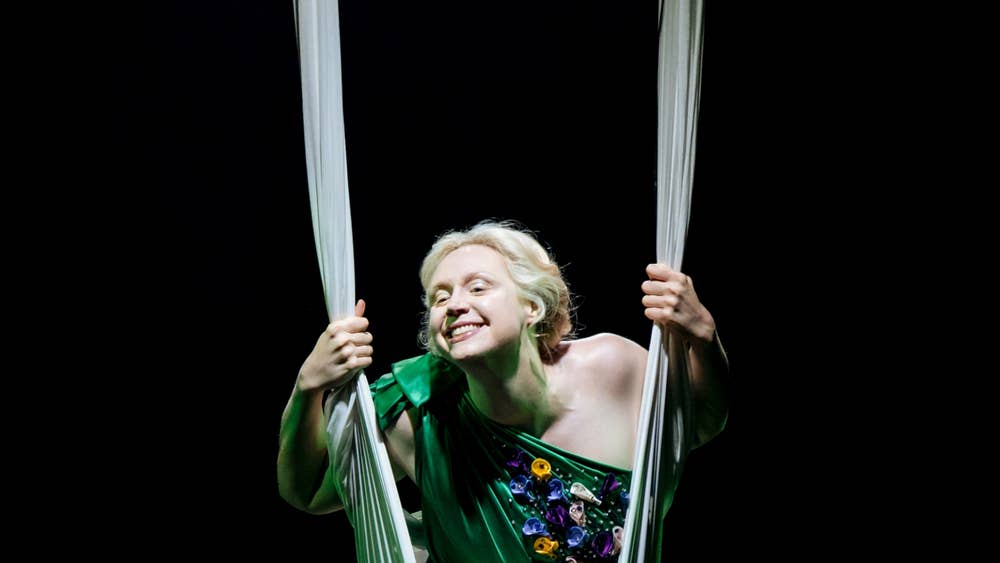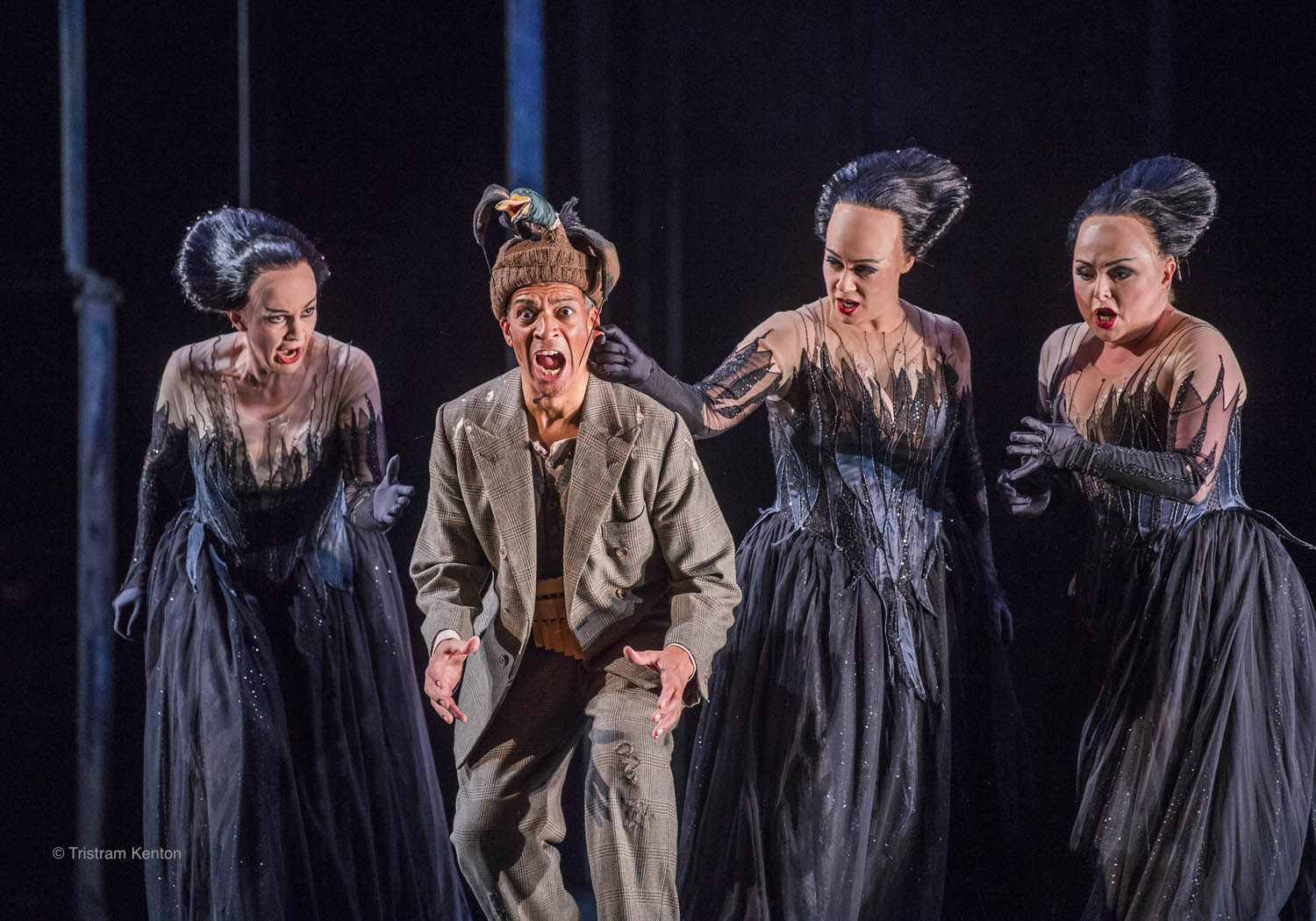VIEWPOINTS – Streaming Diary: Dueling MAGIC FLUTEs, a pair of exceptional Shakespeare productions, and a moving dance/documentary tribute to Alvin Ailey
- By drediman
- July 6, 2020
- No Comments
Aside last week’s main attraction (that would be “Hamilfilm”), I also had the opportunity to stream other fine performing arts related entertainment. Here are my thoughts.
OPERA
Last week can be dubbed as “The Battle of the Magic Flutes”, given my viewings of a pair of very different productions of Mozart’s beloved singspiel. First up was the 2017 revival of the eye-popping Julie Taymor (who was coming off a high from her blockbuster staging of The Lion King) production of Die Zauberflöte (RECOMMENDED), which premiered in 2004 at the Metropolitan Opera to much hoopla (I was lucky enough to have caught that maiden run). The performance was streamed via the Met’s now indispensable Nightly Opera Stream programming, and it featured one of the finer casts to grace Ms. Taymor’s oft-revived, unabashedly fantastical production (Ms. Taymor’s work here was particularly inspired by Eastern cultures). Particularly revelatory were Charles Castronovo and Golda Schultz as Tamino and Tamina, respectively; they provided the whimsical but sometimes disjointed production real heart.
The other Die Zauberflöte (HIGHLY RECOMMENDED) webcast was of another 2017 performance, this one of the Royal Opera House’s production, which was originally staged by David McVicar in 2003, not too long before the premiere of Ms. Taymor’s version. Mr. McVicar is one of the most significant opera directors of his generation, and his productions can be found at many of the world’s great opera houses. Based on the ROH #OurHouseToYourHouse stream, I think I prefer his Age of Enlightenment-inspired staging to its New York counterpart. If Mr. McVicar’s somberly-designed production doesn’t possess the colorful crowd-pleasing spectacle of Ms. Taymor’s version, it boasts more dramatically astute storytelling and a more sophisticated sense of humor. The performances from the mostly young company were very good, although Roderick Williams’ wildly charismatic Papageno nearly stole the show. Musically, both were very fine. The Met’s former maestro, James Levine, characteristically gave Mozart’s buoyant score deeply felt rendition. For the ROH performance, conductor Julia Jones opted for a brisker but no less valid reading.

Gwendoline Christie in the Bridge Theatre’s production of “A Midsummer Night’s Dream” by Shakespeare.
THEATER
This past week, I also streamed exceptional productions of two iconic Shakespeare plays. First up, via NT at Home, I caught the Bridge Theatre’s inspired 2019 production of A Midsummer Night’s Dream (HIGHLY RECOMMENDED). Lauded British director Nicholas Hytner takes great risks in his immersive promenade production, and it pays off in spades. He brings real danger and playful innovation to this most popular of Shakespearian comedies, resulting in an experience that’s both disorienting and daring. The cast was led by a very solid and game Gwendoline Christie (of Game of Thrones fame) as a gender-bending Titania. But like Roderick Williams’ aforementioned turn in Die Zauberflöte, Hammed Animashaun as Bottom all but ran away with the show with his more-is-more shenanigans.
Across the pond in Ontario, Canada, Stratford Festival artistic director Antoni Cimolino continues to prove whey he’s one of the great directors of Shakespeare of his generation. Rarely does Mr. Cimolino fall back on flashy gimmicks to get audiences into the theater. His productions rely simply on Shakespeare’s timeless words to provide all the drama we need. As with his other productions, his 2015 Stratford production of Hamlet (HIGHLY RECOMMENDED), which I also streamed last week, proves to be masterclass in understated elegance and penetrating clarity. As the existentially troubled Danish prince, Jonathan Goad may not be the most ravishing of the lot, but his thoroughly present and thoughtful performance never once threatened to imbalance the play’s downward trajectory. The rest of the accomplished cast included such Stratford stars as Seana McKenna (Gertrude) and Geraint Wyn Davies (Claudius).
Lastly, I caught Bristol Old Vic’s 2016 production (which transferred to the West End in 2017) of The Grinning Man (RECOMMENDED), a curious, robustly-performed new musical based on the Victor Hugo novel “The Man Who Laughs”. Although the score is certainly emotive and ambitious in scope, a certain sameness sets in – both musically and lyrically – after a few numbers. The direction is by Tom Morris (who won awards for War Horse), who has given the show a macabre, parable-like sensibility. Ultimately, I’m more a fan of his moody, puppet-filled staging over the underlying material.
DANCE
In terms of dance, I thought I’d spend more time getting to know Alvin Ailey American Dance Theater better (beyond the perennial “Revelations” and a few other works in the company’s repertoire), particularly given the social reckoning that’s been recently sweeping the country. What I realized in the process was that unlike some other 20th century dance icons – like New York City Ballet’s George Balanchine and his successor Jerome Robbins – I didn’t really know much about the man behind the much-loved company, Alvin Ailey himself. Therefore, I sought out Orlando Bagwell’s multi-disciplinary 1993 documentary A Hymn for Alvin Ailey (RECOMMENDED). The moving hourlong documentary was itself inspired by Hymn, a dance created by the company’s eloquent former artistic director Judith Jamison to commemorate the life and accomplishments of the company’s namesake founder. The documentary follows two threads – the creation of Ms. Jamison’s episodic ballet tribute (including ample footage of the dance, which has been set to material culled from various interviews that’s been arranged/performed by theatrical genius Anna Deavere Smith), as well as a more traditional biography of Mr. Ailey, including relatively succinct segments covering his impressionable early years, rise to prominence, and lasting influence. Thankfully, Mr. Bagwell’s film does not shy away from exploring the dance master’s demons and the truth about his death; Mr. Ailey passed in 1989 due to AIDS-related complications at the age of 58. Paired with background information about Mr. Ailey’s life, the sections featuring Ms. Jamison’s ballet acquire additional impact – and vice versa. It would be tough to create a truly successful documentary about a dancer and/or choreographer without featuring a good dosage of the ephemeral, art that inspired their life. Sometimes words fail.



 Copyright © 2025
Copyright © 2025
Leave a Reply